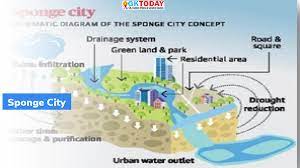
Sponge City Mission in India
Sponge City Mission in India
Main Examination General Studies Question Paper-3
(Need, Benefits and Significance of Sponge City)
October 02, 2023
Why in news:
- In recent years, cities like Hyderabad, Chennai, Gurugram and Mumbai have suffered widespread damage due to heavy rains and floods.
- India's rapid urbanization in view of the increasing frequency of floods has given rise to an urgent need for the development of sponge cities.
- The concept of sponge city is working successfully in cities like Munich, Beijing, Tokyo and Pittsburgh.
Sponge Cities Mission in India:
- Sponge cities are designed to absorb, clean and use rainfall in an environmentally friendly way, reducing harmful and polluted runoff. The concept of sponge cities includes strategies such as permeable roads, rooftop gardens, rainwater harvesting, rain gardens and creation of green and blue spaces such as ponds and lakes.
- Sponge cities aim to increase urban permeability, allowing cities to retain and use the rainfall they receive.
- Sponge City was conceptualized by Chinese professor Kongjian Yu in the year 2013.
- Sponge cities are a new type of eco-cities that provide a holistic strategy to improve ongoing development and urbanization processes by explicitly considering the urban water cycle.
- This can be effectively achieved through an urban mission on the lines of Atal Mission for Rejuvenation and Urban Transformation (AMRUT), National Heritage City Development and Augmentation Yojana (HRIDAY), and Smart Cities Mission.
Why does India need Sponge City Mission:
The following points highlight why Indian cities should turn into 'sponge cities' to deal with urban flooding:
- Urban flooding has become a common phenomenon in major Indian cities. The lack of an effective land policy has contributed to the recurrence of major floods in urban areas.
- Many cities lack proper drainage networks. Every year, trillions of liters of rainwater, a valuable natural resource, is wasted as it is drained directly into gutters, drains and rivers.
- Building concrete structures often releases wastewater, while natural systems retain it. When cities are built on wetlands and ponds, they lose the ability to absorb excess water.
- With cities expanding and the risk of more extreme weather events due to climate change, a long-term approach is needed to address these climate challenges.
- Rising global temperatures are causing more intense rainfall from storms, resulting in devastating urban flooding.
Benefits of Sponge City Mission in India:
- Sponge cities capture, control and reuse every drop of rain.
- They help replenish depleted aquifers and irrigate gardens and urban farms.
- This concept helps in slowing down the water flow, filtering it naturally and recharging the ground water.
- Water saved through the Sponge Cities mission can replace drinking water used to flush toilets and for cleaning purposes.
- This water can also be treated to make it clean enough to drink.
- Sponge cities absorb rainwater, which is naturally filtered by the soil and allowed to reach urban aquifers. It allows water to be extracted from the ground through urban or peri-urban wells.
- In terms of infrastructure, it implies the existence of continuous open green spaces in the neighbourhood, interconnected waterways, channels and ponds that can naturally retain and filter water.
Significance of Sponge City Mission:
- Sponge cities, through innovative design, can solve water problems instead of exacerbating them. Instead of redirecting rainwater, sponge cities retain it for use within their boundaries, increasing our water supply.
- Sponge cities will reduce carbon emissions and contribute to the fight against climate change.
- If implemented properly, a sponge city can reduce the frequency and severity of flooding and improve water quality.
- By capturing storm water, it helps prevent beach pollution.
- It promotes greenery of the city through planting of new plants.
- Related strategies such as green spaces can improve quality of life, improve air quality and reduce urban heat islands.
- Water can be used to maintain green spaces, provide outdoor areas for residents and workers, and even grow food.
- This, in turn, can improve urban ecosystem diversity by providing new habitats for a wider range of organisms.
Challenges:
- The construction of Sponge City poses major challenges related to governance, design and financing.
Mains Exam Question
What is Sponge Cities Mission? Explain the relevance of this mission to combat urban flooding in India.